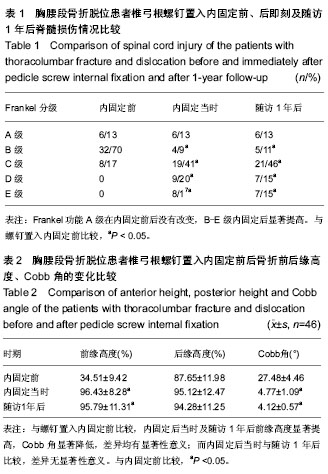| [1] 辜天平. 椎弓根钉系统固定治疗胸腰段椎体骨折50例分析[J]. 中国医药指南,2011,9 (17):15-17.[2] 郑平,袁培义,史宝明,等.体位复位结合器械矫正治疗胸腰段骨折脱位并脊髓损伤[J].中国矫形外科杂志,2001,8(4):337-339.[3] 朱俊昭,王福贵,邹扬道,等.经伤椎椎弓根螺钉内固定治疗胸腰椎骨折脱位[J]. 实用骨科杂志,2011,17(5):391-393. [4] 涂强,许建中.胸腰椎前路短节段内固定器的发展与应用[J].创伤外科杂志,2004,6(2):152-153.[5] Sjovold SG, Zhu Q, Bowden A, et al. Biomechanical evaluation of the Total Facet Arthroplasty System® (TFAS®): loading as compared to a rigid posterior instrumentation system. Eur Spine J. 2012;21(8):1660-1673. [6] Launay O,Charles YP,Steib JP. Should post-traumatic thoracolumbar Frankel A paraplegia be operated as an emergency? Report of three cases and review of the literature.Orthop Traumatol Surg Res.2012;98(3):352-358. [7] 殷国勇,张宁,金正帅.新型扩张器辅助伤椎内植骨结合椎弓根内固定治疗胸腰段爆裂性骨折[J].中华创伤骨科杂志,2009, 11(3): 225-229.[8] 王华东,侯树勋,史亚民,等.经椎弓根椎体内植骨治疗胸、腰椎骨折[J].创伤外科杂志,2006,8(4):328-330.[9] 庄青山,夏德涛,葛吉玉.单节段与短节段椎弓根内固定治疗胸腰段单椎体骨折的疗效比较[J].中华创伤骨科杂志,2010,12(3): 294-296.[10] 魏富鑫,刘少喻,赵卫东,等.单节段与双节段椎弓根螺钉固定胸腰椎单椎体骨折的生物力学比较[J].中国脊柱脊髓杂志,2007, 17(1):46-50.[11] 曹海云.后路经椎弓根内固定结合椎体成形术治疗老年胸腰段脊柱骨折临床观察[J].中国现代药物应用,2011,5(15):32-33.[12] 刘军明.后路经椎弓根内固定结合椎体成形术治疗老年胸腰段脊柱骨折临床分析[J].中国实用医药,2011,6(26):71-72.[13] Kang YJ,Kong JH,Lu GH,et al. Operative strategy of the thoracolumbar fracture dislocation. Zhong Nan Da Xue Xue Bao Yi Xue Ban.2007;32(1):148-152.[14] Peng J,Xu J. Research progress in surgical treatment of thoracolumbar fracture.Zhongguo Xiu Fu Chong Jian Wai Ke Za Zhi.2009;23(12):1506-1509. [15] Stancic MF,Gregorovic E,Nozica E,et al. Anterior decompression and fixation versus posterior reposition and semirigid fixation in the treatment of unstable burst thoracolumbar fracture: prospective clinical trial. Croat Med J. 2001;42(1):49-53.[16] 范志丹,夏虹,昌耘冰,等.伤椎传统短节段椎弓根螺钉固定与附加椎弓根螺钉固定后椎体生物力学稳定性的比较[J].中国组织工程研究与临床康复,2008,12(26):5011-5017.[17] Gao B,Xing R,Kong Q,et al. Subtotal corpectomy and intervertebral bone grafting through posterior approach alone in treatment of thoracolumbar burst fracture or thoracolumbar fracture-dislocation.Zhongguo Xiu Fu Chong Jian Wai Ke Za Zhi. 2012;26(5):542-545. [18] Li H,Xing G,Yang C,et al. Biomechanical study and clinical application of distraction reduction fixation system for treating thoracolumbar vertebral fracture. Zhongguo Xiu Fu Chong Jian Wai Ke Za Zhi.2008;22(8):923-927. |

